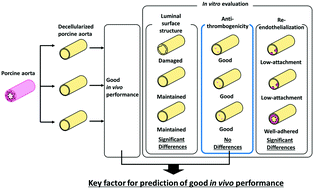In vitro evaluation of surface biological properties of decellularized aorta for cardiovascular use
Abstract
The aim of this study was to determine an in vitro evaluation method that could directly predict in vivo performance of decellularized tissue for cardiovascular use. We hypothesized that key factors for in vitro evaluation would be found by in vitro assessment of decellularized aortas that previously showed good performance in vivo, such as high patency. We chose porcine aortas, decellularized using three different decellularization methods: sodium dodecyl-sulfate (SDS), freeze–thawing, and high-hydrostatic pressurization (HHP). Immunohistological staining, a blood clotting test, scanning electron microscopy (SEM) analysis, and recellularization of endothelial cells were used for the in vitro evaluation. There was a significant difference in the remaining extracellular matrix (ECM) components, ECM structure, and the luminal surface structure between the three decellularized aortas, respectively, resulting in differences in the recellularization of endothelial cells. On the other hand, there was no difference observed in the blood clotting test. These results suggested that the blood clotting test could be a key evaluation method for the prediction of in vivo performance. In addition, evaluation of the luminal surface structure and the recellularization experiment should be packaged as an in vitro evaluation because the long-term patency was probably affected. The evaluation approach in this study may be useful to establish regulations and a quality management system for a cardiovascular prosthesis.



 Please wait while we load your content...
Please wait while we load your content...